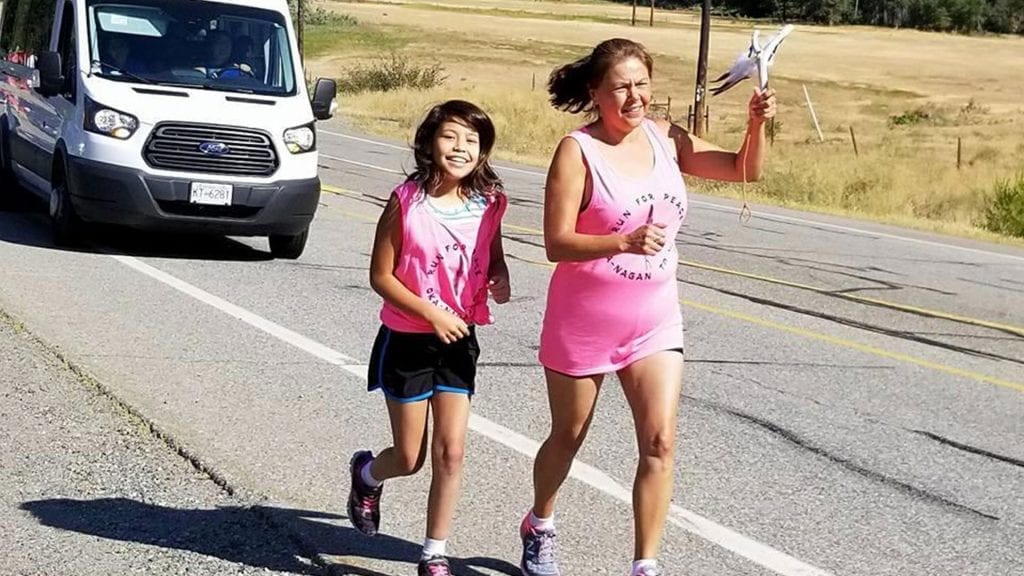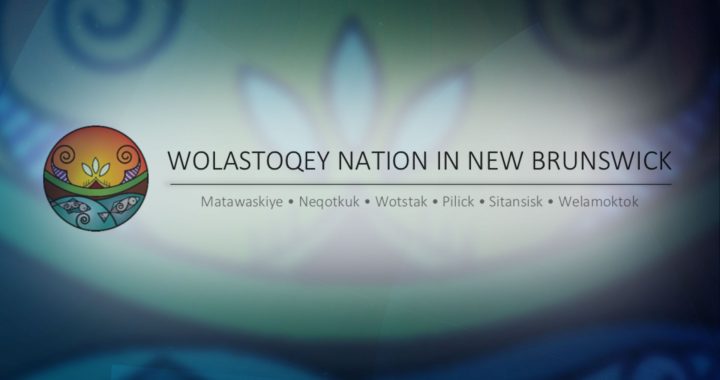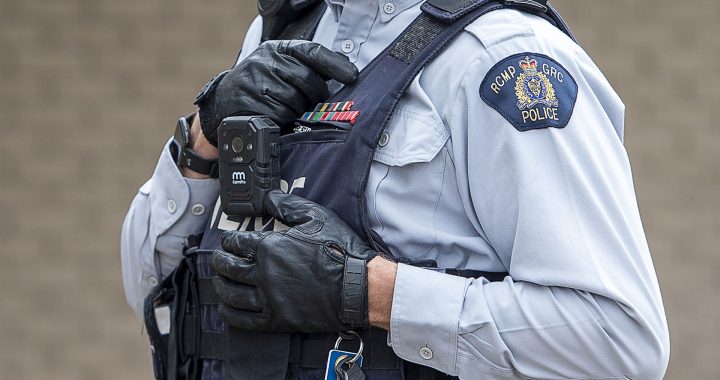
Anna Tonasket and her little cousin run with the eagle feather at the Okanagan Nation Alliance tribute in 2017. Photo courtesy: Anna Tonasket
In the summer of 1990, Anna Tonasket, a Sqilxw woman, joined over 70 Okanagan Nation members in the Run for Peace. It travelled from the Okanagan to Oka, Que., and those who made it to their final destination ran for six weeks.
Their journey was in response to and during the 1990 Siege of Kanehsatà:ke, also known as the Oka Crisis, a 78-day stand-off that began on July 11. It was between the Kanien’kehá:ka (People of the Flint, or commonly known as Mohawk people) of Kanehsatà:ke, the Quebec police and the Canadian military over a land dispute in Oka.
Now, Tonasket reflects back on the past 30 years and explains that First Nations people are still fighting.
“Unfortunately, things haven’t changed, you know, our people are still fighting the fight. The crisis was 30 years ago, but our people have been fighting for hundreds of years,” Tonasket says.
“And we’re still, it’s 2020, and we’re still fighting, you know, for recognition and acknowledgement, you know, as the First Peoples on Turtle Island.”
The 1990 siege began when the Town of Oka proposed an expansion to a local golf course and the development of condominiums on Mohawk territory that was never ceded, and included sacred burial grounds. The Kanien’kehá:ka of Kanehsatà:ke set up a roadblock in the Pines to protest the expansion of the golf course.
The Kanien’kehá:ka of Kahnawà:ke also showed their support by blockading the Mercier Bridge. On July 11, 1990 the militarized Sûreté du Québec (SQ) police was dispatched to raid the blockade on the road in the Pines, using tear gas, grenades, and began firing bullets. In the end, Cpl. Marcel Lemay was fatally wounded.
This sparked a 78-day standoff between the Kanien’kehá:ka and the militarized SQ and military, who were sent in by the government to the community of Kanehsatà:ke. Nations from across Turtle Island showed their support, by creating their own blockades, and many traveling to Kanehsatà:ke. The expansion was eventually cancelled, and the land was purchased by the federal government, but the land dispute was never resolved.
On Saturday, July 11, the 30th anniversary of the Siege, in a joint statement, the Rotinonhsión:ni (People of the Longhouse) of Kahnawà:ke and Kanehsatà:ke, said, “Today, we honor and remember the women, men, elders, and children who all played a significant role in the summer of 1990.”
They continue, “In many ways, the situation in both of our communities remains the same. Our ancestral lands still face theft and dispossession: our traditional governments de-legitimatized [sic] by colonial created political entities by the Government of Canada and Quebec.”
As the commemoration took place this past Saturday, Tonasket, a member of the Okanagan Indian Band and Penticton Indian Band, remembers vividly why she took part in the run.
“The Okanagan to Oka Run for Peace was a way for us to support our Mohawk brothers and sisters,” she explains.
“It had gotten back to our community that they were blockading their community trying to stop the golf course from going through, digging up their ancestral burial ground.”
“We decided that we wanted to support. So the Penticton Indian Band, along with several other Syilx Bands, erected blockades into their community as a show of solidarity for the Mohawks. So basically, that’s, it was in support and solidarity, and to bring awareness about what was going on within the Mohawk territory.”
Tonasket, who was 28 years old at the time, was originally scheduled to be a checkpoint cook on the route. She was asked to be a runner instead after some Mohawks reached out.
“They were calling, you know, with regard to our people running across the country, with the feather to present to their community,” Tonasket explains.
“One of the questions that was asked was, ‘Where are your women?’ Because at that time, there were, all the runners were male. And so they said, you know, you have to have your women with you. And so Arnie Louie and, I believe it was Jeannette Armstrong, approached me and asked if I would join the run.”
The runners departed in early August. Shortly after running the first two kilometres, Tonasket says they pulled over and she received another request.
“I get into this rented car with them and the band pulls out and, and then I’m told, ‘Oh, well you need to be the female spokesperson for the group,’” she says.
Tonasket explains that she was tasked with going ahead of the runners and securing lodging, food and being a spokesperson to the media as they crossed various territories.
“It was exciting, it was scary at times, it was humbling,” says Tonasket. “There were times of, you know, you could just feel the pride in our runners.”
But the runners were also met with racism, discrimination and opposition for running, she adds.
“We had people yelling and swearing at us, and some places wouldn’t serve us or you could, you know, if we had to pull in and get gas, there was, you could just feel the animosity,” says Tonasket. “And so we were very clear as a group that no one went anywhere by themselves for any reason.”
A delegation of Kanien’kehá:ka women met them in Regina, Sask., says Tonasket, and they all continued east towards Kanehsatà:ke.
“There was Donna Goodleaf, and then there were four ambassadors, young women,” she explains.
Donna Kahérakwas Goodleaf, too, remembers the run well, and the significance of meeting the runners in Regina.
“Well, from what I can remember, I think you have to put it into context that the Okanagan Confederacy, the Okanagan-Shuswap Confederacy, we have a spiritual alliance with each other, so they have a spiritual alliance with our people, with the Haudenosaunee Confederacy,” says Goodleaf.
A citizen of the Kanien’kehá:ka Nation, Goodleaf is now the director of decolonizing curriculum and pedagogy at Concordia University. She says coming together was “fulfilling a spiritual relationship.”
“Between both of our Nations of people, confederacies of people from the Eastern Door, and the Okanagan and Shuswap represent the Western Door. And so bringing our people together to run together, across Turtle Island was quite powerful,” Goodleaf explains.
Most of the runners, including Tonasket, finished their part of the run in Ottawa, Ont. as they got word from some Mohawks that it was too dangerous to continue, she says.
“We got to Ottawa and we were at the [Assembly of First Nations] building,” says Tonasket. “That’s where we had spent the night, and it was while we were there that we received word that it was quite dangerous that the Mohawk people, you know, were quite fearful for the lives of the runners.”
The eagle feather and bundle continued on with a smaller delegation and made it safely to Kanehsatà:ke, she explains, where they were treated “very, very well” by the Mohawk people.
As the Rotinonhsión:ni concluded in their press statement, “The summer of 1990 serves as a reminder that the Kanien’kehà:ka are willing to defend their land and protect their people, by any means necessary. The same holds true, 30 years later.”
In fact, Tonasket says that the original runners and families had been planning to return to Kanehsatà:ke this past Saturday for the anniversary of the peace run, but that was cancelled due to the COVID-19 pandemic.
“Everything just kind of went out the window,” she says.
But as the original run lasted over six weeks, lifelong bonds were built.
“The friendships that have remained, I think amongst the majority of the people who participated back in 1990, it’s still as strong today as it was there 30 years ago,” says Tonasket.
“And sadly, we’ve lost, you know, both of our spiritual leaders and many of our original runners…so always, you know, keeping them and their families in our thoughts, especially, around July 11.”
It wasn’t only friends that were gained during the Run for Peace, says Tonasket, but a strength that powers on today.
“It was a very powerful time, I think in our people’s history, it really brought out people’s compassion and empathy. And it also, I think, was a huge display of the resilience that our people have when we stand up and we stand up together.”
Chehala is reporting from the Okanagan for The Discourse as part of the Local Journalism Initiative. She’s a journalist and documentary producer from the Aseniwuche Winewak Nation, near Grande Cache, Alberta. Her work is featured on IndigiNews.com, a new platform created by The Discourse and APTN.










